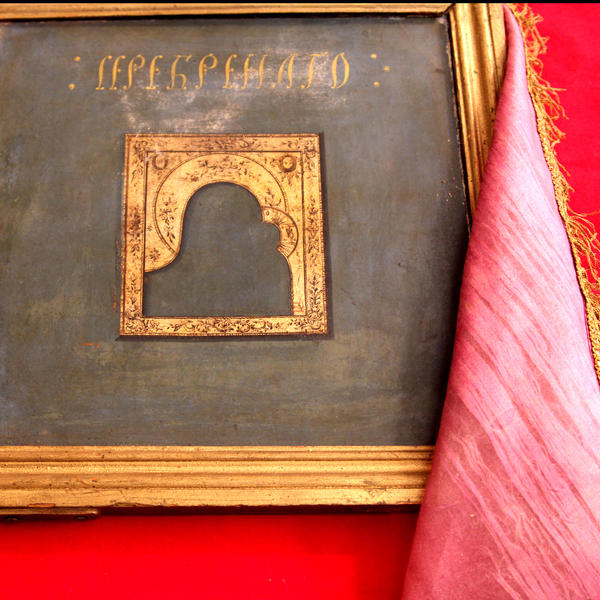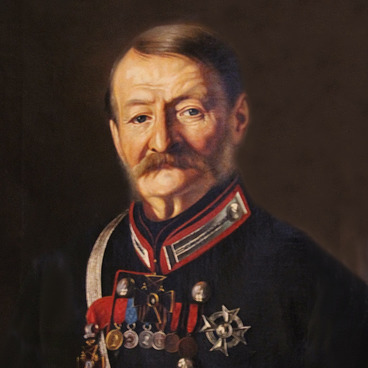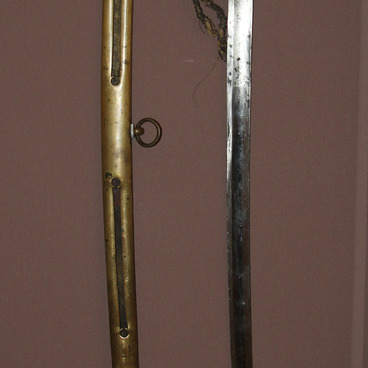The banner of the 19th century kept in the museum belonged to a silversmith workshop in Kaluga.
Historians discovered the first information about Kaluga silversmiths in the cadastre of 1617. In the town residency book of the next decade, it was stated that silversmiths traded in the ostrog, ‘a little further from the fish row’. However, they were not located in shops, but on seven benches near the ‘buttermen’. And by 1685 silversmiths had already had four shops on the Trade Square in the Kaluga Governorate.
One of the most famous silver craftsmen was the merchant of the second guild Maxim Zolotaryov. His works were a popular commodity at large town fairs, and the master himself traded in the Silver Row in Kaluga. Zolotaryov also served as the head of the assay chamber, which monitored the compliance of precious metal products with the fineness indicated on them. These days many objects created by Zolotaryov are included in the collections of major Russian museums. These are chased dishes, oklad bars, jugs and teapots, as well as church utensils. The master branded his work with his personal mark ‘МКЗ’ (‘MXZ’).
The first guild banners appeared in Russia in 1722 when Peter I introduced the so-called ‘guild system’. The emperor borrowed the idea of distributing all the workers and small traders into corporations in Western Europe.
According to the new system, artisans were divided into masters, apprentices and students. For each category there was determined a training period, and in order to get the title of master it was necessary to pass a kind of examination.
To become a member of a corporation, it was required to make a model product. In France they were called ‘chefs-d'œuvre’, and from there this word came into the Russian language. Each corporation consisted of artisans who lived in the same town, worked in their workshop and knew all the secrets of a particular business. Such an organisation helped to establish the work of its members and control their composition.
Under Catherine II, the corporation system consolidated, and also there was formed legislation that regulated the activities of craftsmen. Corporations got coats of arms and banners. Researchers believe that merchant guilds were the first to introduce such distinctive signs. The more artisan corporations appeared in the 18th century, the more varied their emblems became. Along with images of heraldic animals on banners and coats of arms, they often depicted tools or products that were associated with a particular corporation.
At that time, corporations began to manage not only the work of artisans, but also other areas of urban life. For example, a formed corporation with a coat of arms and a banner was responsible for the defence of a particular section of the town wall in the event of an attack on the town. Also, the corporation could collect contributions and help the families of their seriously ill or deceased members with payments.
Historians discovered the first information about Kaluga silversmiths in the cadastre of 1617. In the town residency book of the next decade, it was stated that silversmiths traded in the ostrog, ‘a little further from the fish row’. However, they were not located in shops, but on seven benches near the ‘buttermen’. And by 1685 silversmiths had already had four shops on the Trade Square in the Kaluga Governorate.
One of the most famous silver craftsmen was the merchant of the second guild Maxim Zolotaryov. His works were a popular commodity at large town fairs, and the master himself traded in the Silver Row in Kaluga. Zolotaryov also served as the head of the assay chamber, which monitored the compliance of precious metal products with the fineness indicated on them. These days many objects created by Zolotaryov are included in the collections of major Russian museums. These are chased dishes, oklad bars, jugs and teapots, as well as church utensils. The master branded his work with his personal mark ‘МКЗ’ (‘MXZ’).
The first guild banners appeared in Russia in 1722 when Peter I introduced the so-called ‘guild system’. The emperor borrowed the idea of distributing all the workers and small traders into corporations in Western Europe.
According to the new system, artisans were divided into masters, apprentices and students. For each category there was determined a training period, and in order to get the title of master it was necessary to pass a kind of examination.
To become a member of a corporation, it was required to make a model product. In France they were called ‘chefs-d'œuvre’, and from there this word came into the Russian language. Each corporation consisted of artisans who lived in the same town, worked in their workshop and knew all the secrets of a particular business. Such an organisation helped to establish the work of its members and control their composition.
Under Catherine II, the corporation system consolidated, and also there was formed legislation that regulated the activities of craftsmen. Corporations got coats of arms and banners. Researchers believe that merchant guilds were the first to introduce such distinctive signs. The more artisan corporations appeared in the 18th century, the more varied their emblems became. Along with images of heraldic animals on banners and coats of arms, they often depicted tools or products that were associated with a particular corporation.
At that time, corporations began to manage not only the work of artisans, but also other areas of urban life. For example, a formed corporation with a coat of arms and a banner was responsible for the defence of a particular section of the town wall in the event of an attack on the town. Also, the corporation could collect contributions and help the families of their seriously ill or deceased members with payments.



